Research and Application of Drilling Fluid Cooling System for Dry Hot Rock
Abstract
1. Introduction
2. Method of Design of Drilling Fluid Cooling System for GH-02 Well
2.1. Overall Design of System Components
2.2. Calculation of Circulating Heating Power of Drilling Fluid
- (1)
- The drilling fluid is an incompressible and uniform medium, and its thermal and physical parameters do not change with temperature during the circulation process;
- (2)
- The surrounding rock is an isotropic homogeneous medium, and its thermal and physical properties do not change with temperature or pressure;
- (3)
- Ignoring the radial temperature gradient of the drilling fluid inside the wellbore, the temperature of the drilling fluid inside the wellbore is continuous in the z-direction;
- (4)
- Only the heat transfer in the r-direction of the surrounding rock is considered.
- When only considering the heat transfer in the r-direction, this means that there is no heat flux at the upper and lower boundaries of the geometric model, and therefore the upper and lower boundaries are adiabatic boundaries;
- The temperature of the surrounding rock far away from the wellbore has not been disturbed, which means that the right boundary temperature of the geometric model is still equal to the initial geotemperature;
- The left boundary is a coupled thermal boundary. This indicates that the left boundary represents both the temperature field of the drilling fluid inside the wellbore (Tp and Ta) and the temperature field of the surrounding rock boundary (Tr). The heat transfer between Tp, Ta, and Tr is determined by the total heat transfer coefficient and the temperature difference;
- The wellhead drilling fluid is injected at a certain temperature. At the bottom of the well, the temperature in the drill pipe is equal to the temperature of the annulus.
- The initial values of all temperature physical fields are equal to the initial geotemperature.
2.3. Calculation of Heat Exchange Area of Heat Exchanger
3. Field Application and Result Analysis
3.1. Application of Dry Hot Rock Trial Production Wells
3.2. Promotion and Application in Shale Oil Wells
4. Conclusions
- (1)
- This article designs and develops a closed drilling fluid cooling system, which mainly includes a coolant cooling module, a convective heat exchange module, and a monitoring and control module. The coolant cooling module adopts a cascade cooling mode, with evaporative cooling as the main method and forced cooling to increase efficiency. The wide gap stainless steel spiral plate heat exchanger is preferred, and can achieve one-click constant-temperature automatic operation.
- (2)
- A transient temperature prediction model for the wellbore circulation is established based on the formation conditions and drilling design of the dry hot rock trial production well. Under the conditions of a drilling fluid displacement of 30 L/s and a bottomhole circulation temperature not exceeding 105 °C, the inlet and outlet temperatures of the drilling fluid are calculated to be 55.6 °C and 69.2 °C, respectively, and the circulating heat transfer is not less than 1785 kW. By selecting a reserve coefficient of 1.5 and a heat transfer efficiency of 80%, the heat transfer area of the spiral plate heat exchanger is calculated to be no less than 75 m2.
- (3)
- The drilling fluid cooling system designed in this article has been applied to the GH-02 dry hot rock trial production well and the shale oil well in Dagang Oilfield, and has achieved ideal application results. During the operation of the drilling fluid cooling equipment, the rheological properties of the drilling fluid are stable, and the evaporation rate is significantly reduced. At the same time, the failure rate of the drilling mud pumps significantly decreases, and the performance and service life of downhole tools such as the drill bits, screws, and MWD are stable. The imaging logging instruments are smoothly deployed, and the drilling system operates safely and efficiently.
Author Contributions
Funding
Data Availability Statement
Conflicts of Interest
References
- Duchane, D.; Brown, D. Hot dry rock (HDR) geothermal energy research and development at Fenton Hill, New Mexico. Geo-Heat Cent. Q. Bull. 2002, 23, 13–19. [Google Scholar]
- Chen, Z.; Wang, X.; Peng, B.; Zhang, H.; Li, Z.; Gong, H. Research Status and Progress on Technologies for Exploration of Dry Hot Rock Resources in China. J. Phys. Conf. Ser. 2024, 2913, 012002. [Google Scholar] [CrossRef]
- Zhang, J.; Liu, Y.; Lv, J. Investigation of heat extraction performance of supercritical CO2 in 2D self-affine rough intersecting fracture. Geoenergy Sci. Eng. 2024, 243, 213352. [Google Scholar]
- Zhang, J.; Liu, Y.; Lv, J.; Gao, W. The flow and heat transfer characteristics of supercritical mixed-phase CO2 and N2 in a 3D self-affine rough fracture. Energy 2024, 303, 131967. [Google Scholar]
- Wen, D.; Zhang, E.; Wang, G. Progress and Prospect of Hot Dry Rock Exploration and Development. Hydrogeol. Eng. Geol. 2023, 50, 1–13. [Google Scholar]
- Pan, D.; Wang, D.; Huang, J.; Zhang, W.; Zhao, Z.; He, Y. Case Analysis of DST Tools Low-Frequency Failures in HTHP Deep Well. Drill. Prod. Technol. 2023, 46, 165. [Google Scholar]
- Zhang, K.; Zhang, J.; Dai, W. Drilling technology for deep & ultra-deep well in West China. Drill. Prod. Technol. 2010, 33, 36–40. [Google Scholar]
- Hou, B.; Liu, W.; Han, L.; Liu, A. Research and application of 300 °C directional drilling system. China Pet. Mach. 2018, 46, 1–9. [Google Scholar]
- Guenot, A.; Maury, V. Practical advantages of mud cooling systems for drilling. SPE Drill. Complet. 1995, 10, 42–48. [Google Scholar]
- Li, W.; Huo, H.; Liu, H.; Zhang, L.; Jin, N.; Liu, X.; Liu, C.; Jia, S. Design and Application of a Mud Cooling Method for Offshore High Temperature Wells. In Proceedings of the ISOPE International Ocean and Polar Engineering Conference, Rhodes, Greece, 16–21 June 2024; ISOPE: Mountain View, CA, USA, 2024; p. ISOPE-I-24-073. [Google Scholar]
- Finger, J.; Jacobson, R.; Whitlow, G.; Champness, T. Insulated Drill Pipe for High-Temperature Drilling; Sandia National Laboratories: Albuquerque, NM, USA, 2000.
- Kohei, A.; Naganawa, S.; Bjarkason, E.K. Application of Insulated Drill Pipe to Supercritical/Super-Hot Geothermal Well Drilling. In Proceedings of the International Conference on Offshore Mechanics and Arctic Engineering, Melbourne, Australia, 11–16 June 2023; American Society of Mechanical Engineers: New York, NY, USA, 2023; p. V009T11A042. [Google Scholar]
- Liu, J.; Chen, E.; Li, G.; Yuan, L. Experimental study of drilling fluid cooling in deep wells based on phase change heat storage. Pet. Drill. Tech. 2021, 49, 53–58. [Google Scholar]
- Khan, A.; Bradshaw, C.R. Quantitative comparison of the performance of vapor compression cycles with compressor vapor or liquid injection. Int. J. Refrig. 2023, 154, 386–394. [Google Scholar]
- Li, K.; Zhang, Y.; Sun, Y.; Guo, W.; Li, B. Research and optimization of mud cooling system in gas hydrate drilling. Drill. Prod. Technol. 2013, 36, 34–36. [Google Scholar]
- Xi, Q.; Peng, J.; Dai, Q.; Zhou, Q.; Tang, C.; Yang, Q. Development of ZLQ030-75 High Temperature Drilling Fluid Cooling Device. Oil Field Equip. 2023, 52, 53–58. [Google Scholar]
- Liu, W.; Sun, Y.; Guo, W.; Li, B.; Li, Z. Comparative Analysis and Research on Light Pipe and Threaded Pipe Type Heat Exchanger of Mud Refrigeration. Prospect. Eng. Geotech. Drill. Eng. 2013, 40, 5. [Google Scholar]
- Li, K.; Zhang, Y.; Wang, H.; Liang, J.; Li, X.; Wu, J.; Li, X. Design of Cooling System for Gas Hydrate Drilling Mud in Frozen Soil Region and the Calculation of Important Factors. Prospect. Eng. Geotech. Drill. Eng. 2014, 41, 45–48. [Google Scholar]
- Liang, X.; Zhao, C.; Zhao, X.; Zhang, Y.; Bai, Y.; Yang, M. Development of the Drilling Fluid Surface Cooling System Based on Heat Pipes. China Pet. Mach. 2023, 51, 24–32. [Google Scholar]
- Yang, M.; Tang, D.; Chen, Y.; Li, G.; Zhang, X.; Meng, Y. Determining initial formation temperature considering radial temperature gradient and axial thermal conduction of the wellbore fluid. Appl. Therm. Eng. 2019, 147, 876–885. [Google Scholar]
- Wang, X.; Wang, Z.; Deng, X.; Sun, B.; Zhao, Y.; Fu, W. Coupled thermal model of wellbore and permafrost in Arctic regions. Appl. Therm. Eng. 2017, 123, 1291–1299. [Google Scholar]
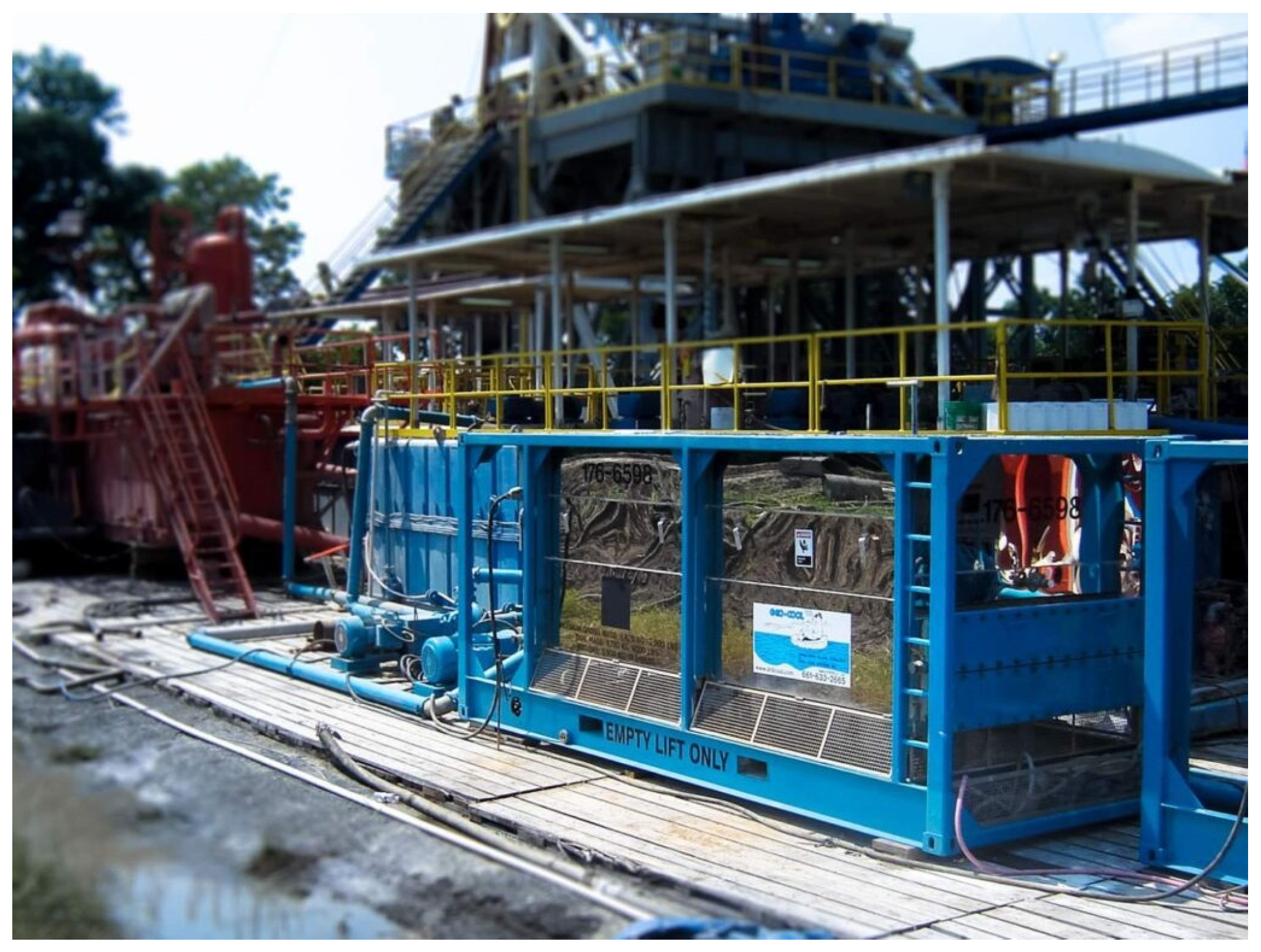
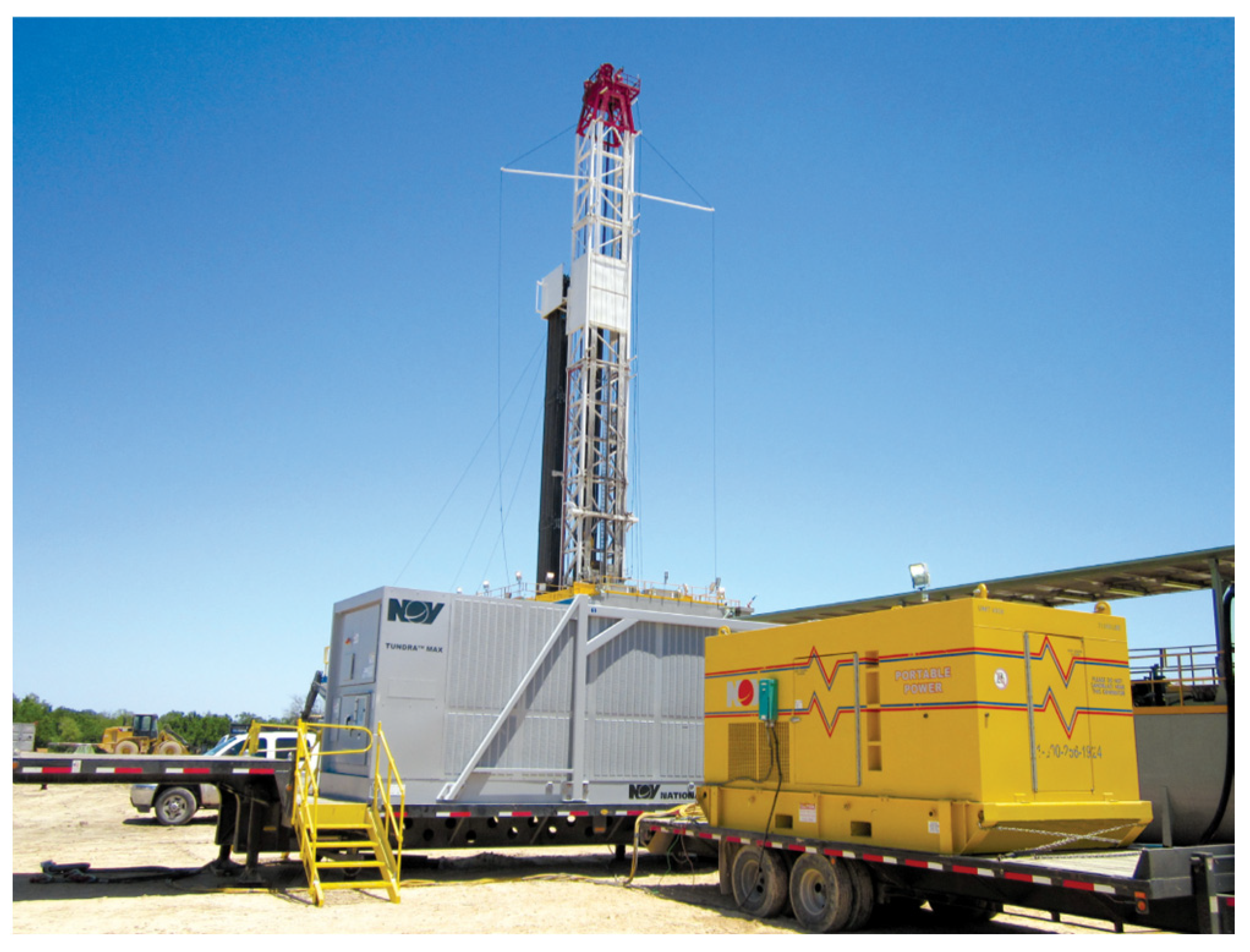
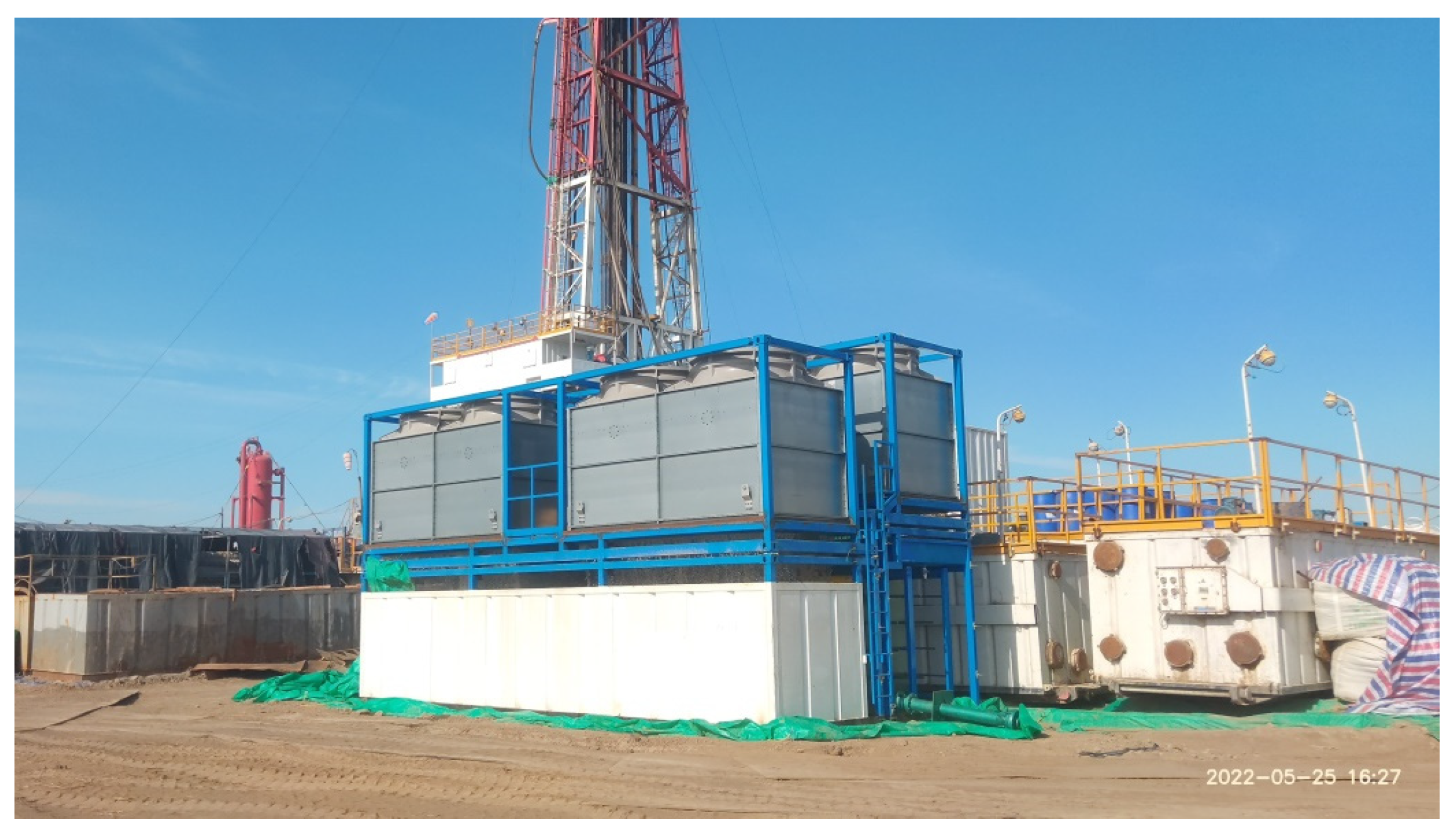


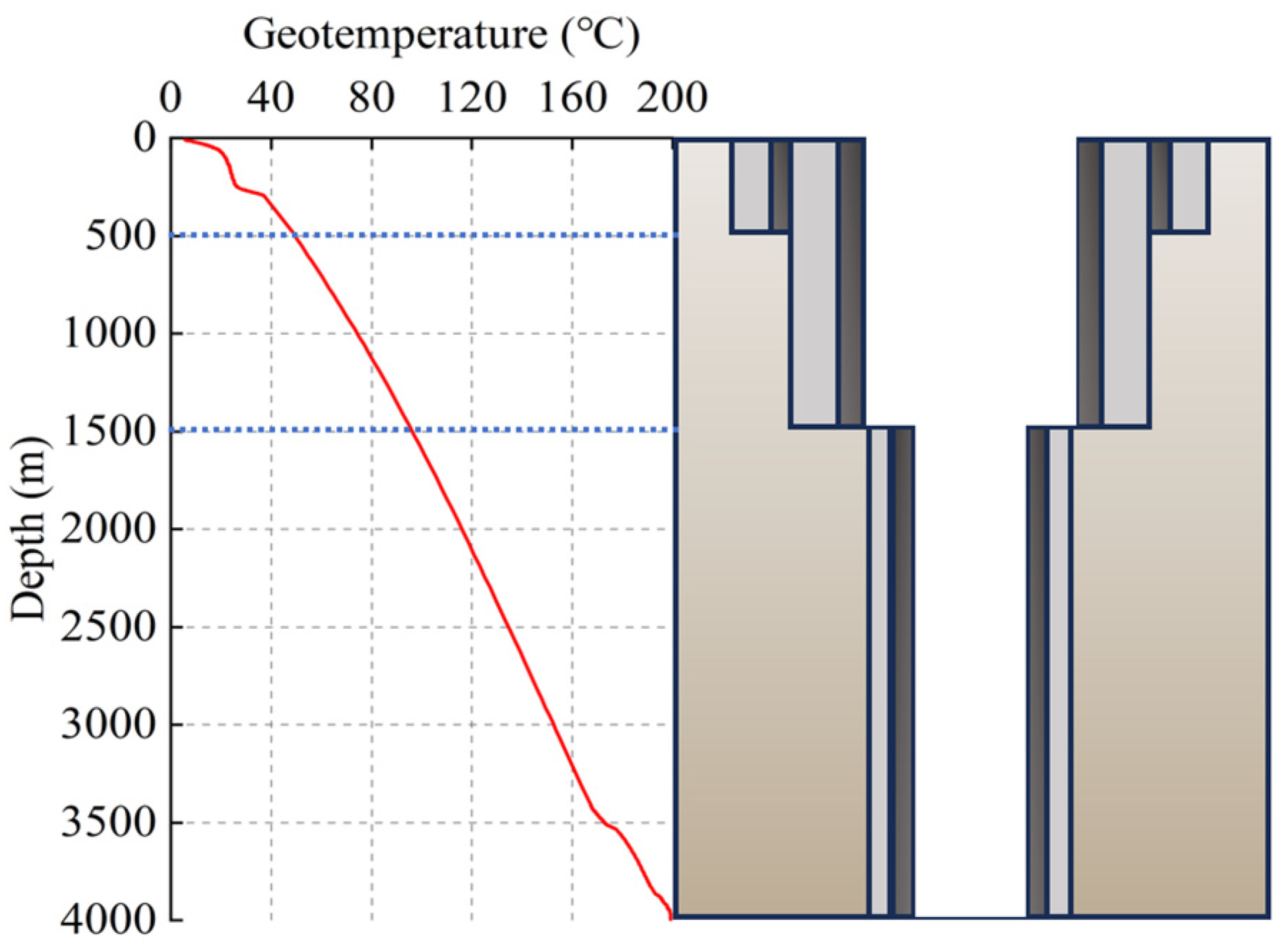


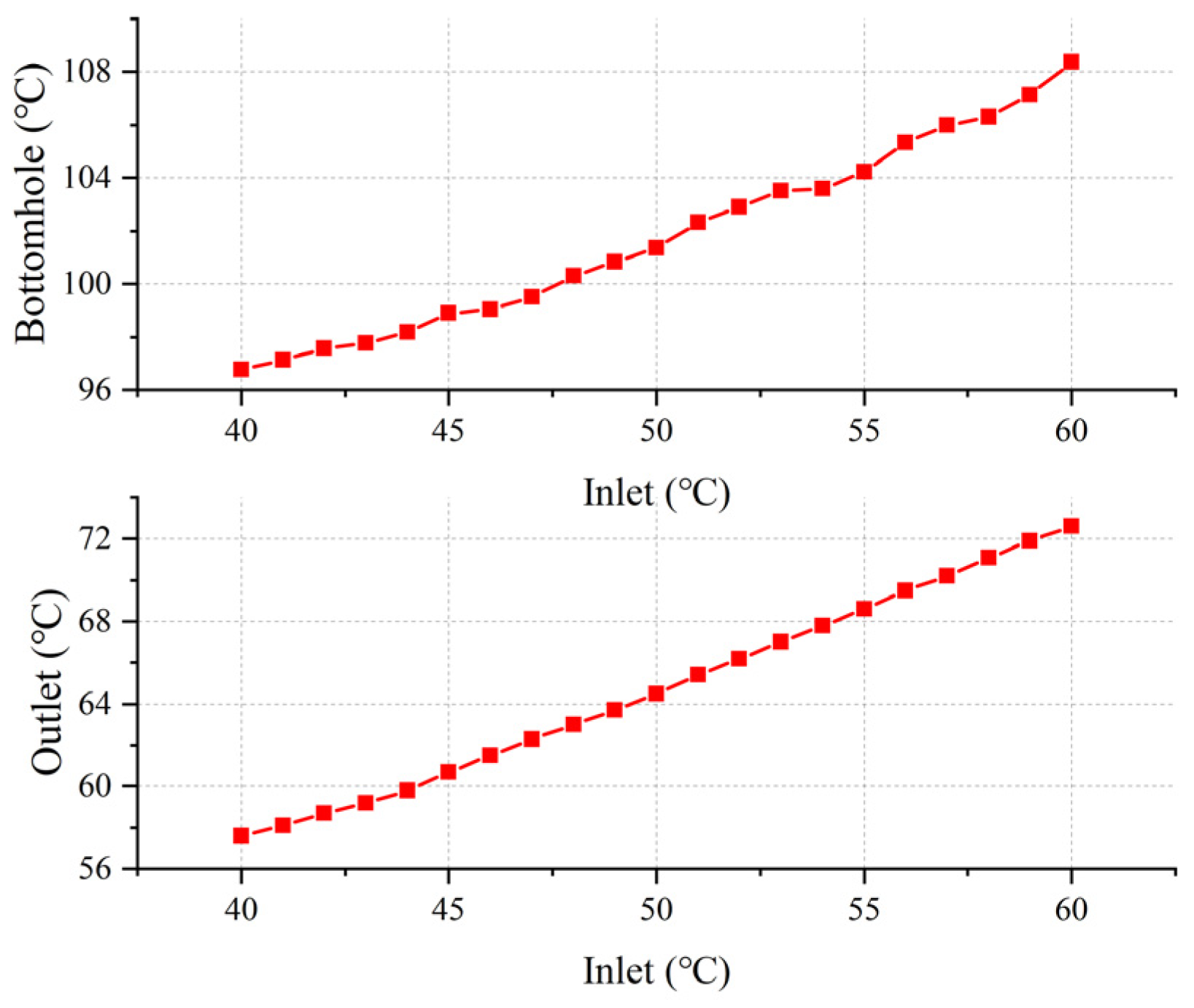
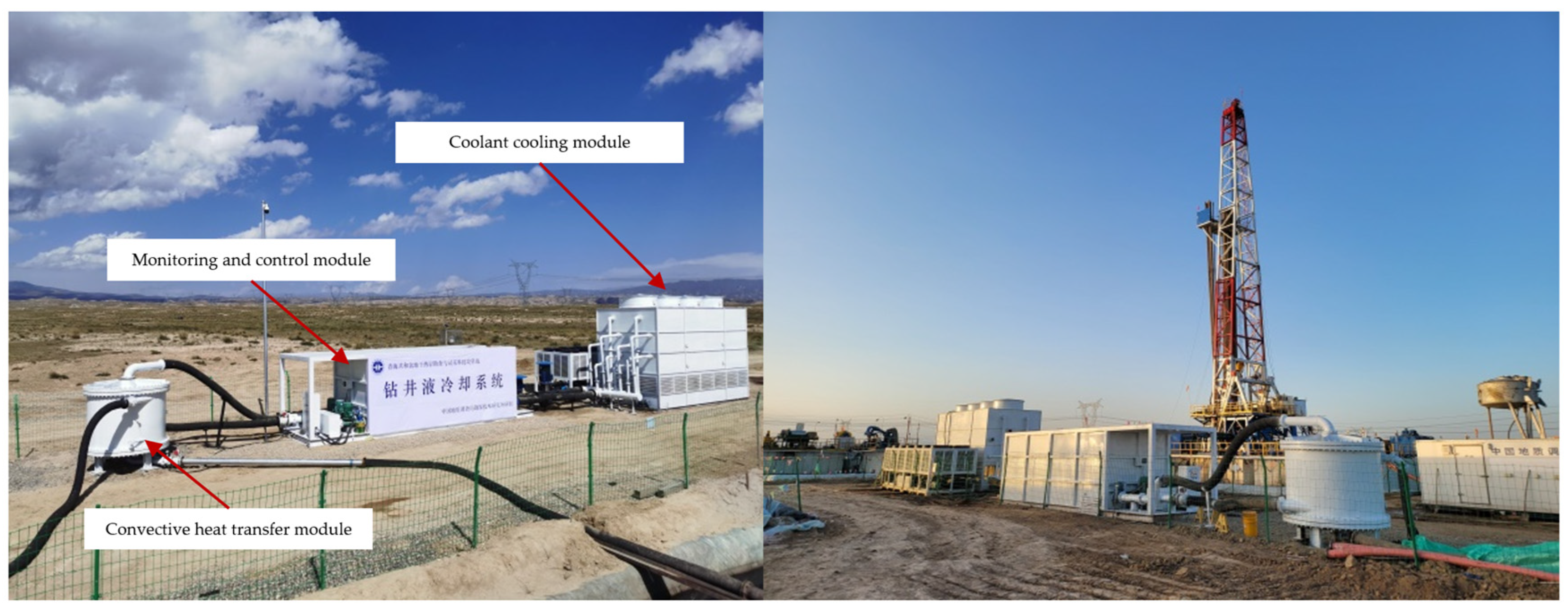


| Diameter of Drill Bit (mm) | Specification of Casing (mm) | Depth (m) | Cement Slurry Return Height (m) | |
|---|---|---|---|---|
| First layer | 444.5 | 339.7 × 10.92 | 0–500 | 500 |
| Second layer | 311.2 | 244.5 × 10.03 | 0–1500 | 1500 |
| Third layer | 215.9 | 177 × 11.51 | 1500–4000 | 2500 |
| Parameter | Symbol | Unit | Value | |
|---|---|---|---|---|
| Inlet temperature | Drilling fluid | T11 | °C | 69.2 |
| Refrigerant | T21 | °C | 28.0 | |
| Outlet temperature | Drilling fluid | T12 | °C | 48.8 |
| Refrigerant | T22 | °C | 42.4 | |
| Circulating flow rate | Drilling fluid | Q1 | m3/h | 86.4 |
| Refrigerant | Q2 | m3/h | 160 | |
| Density | Drilling fluid | ρ1 | g/cm3 | 1.33 |
| Refrigerant | ρ2 | g/cm3 | 1.00 | |
| Specific heat | Drilling fluid | c1 | J/(kg·°C) | 3290 |
| Refrigerant | c2 | J/(kg·°C) | 4200 | |
| Thermal conductivity | Drilling fluid | λ1 | W/(m·°C) | 0.62 |
| Refrigerant | λ2 | W/(m·°C) | 0.59 | |
| Dynamic viscosity | Drilling fluid | μ1 | mPa·s | 15 |
| Refrigerant | μ2 | mPa·s | 1.01 | |
| Kinematic viscosity | Drilling fluid | γ1 | m2/s | 11.28 × 10−6 |
| Refrigerant | γ1 | m2/s | 1.01 × 10−6 | |
| Thickness of heat exchanger plates | δ | mm | 4 | |
| Thermal conductivity of heat exchanger plates | λ | W/(m·°C) | 16.2 | |
Disclaimer/Publisher’s Note: The statements, opinions and data contained in all publications are solely those of the individual author(s) and contributor(s) and not of MDPI and/or the editor(s). MDPI and/or the editor(s) disclaim responsibility for any injury to people or property resulting from any ideas, methods, instructions or products referred to in the content. |
© 2025 by the authors. Licensee MDPI, Basel, Switzerland. This article is an open access article distributed under the terms and conditions of the Creative Commons Attribution (CC BY) license (https://creativecommons.org/licenses/by/4.0/).
Share and Cite
Li, K.; Li, B.; Shi, S.; Wu, Z.; Zhang, H. Research and Application of Drilling Fluid Cooling System for Dry Hot Rock. Energies 2025, 18, 1736. https://doi.org/10.3390/en18071736
Li K, Li B, Shi S, Wu Z, Zhang H. Research and Application of Drilling Fluid Cooling System for Dry Hot Rock. Energies. 2025; 18(7):1736. https://doi.org/10.3390/en18071736
Chicago/Turabian StyleLi, Kuan, Bing Li, Shanshan Shi, Zhenyu Wu, and Hengchun Zhang. 2025. "Research and Application of Drilling Fluid Cooling System for Dry Hot Rock" Energies 18, no. 7: 1736. https://doi.org/10.3390/en18071736
APA StyleLi, K., Li, B., Shi, S., Wu, Z., & Zhang, H. (2025). Research and Application of Drilling Fluid Cooling System for Dry Hot Rock. Energies, 18(7), 1736. https://doi.org/10.3390/en18071736






